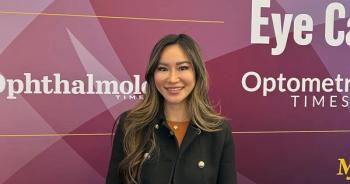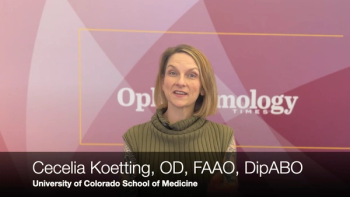
MGD Patient Case #2
Dr David Kading shares a patient case of MGD demonstrating gradual improvement through thermal pulsation therapy.
Here is the second case from the round table we were doing. This is a 42-year-old [woman] who was here for an eye exam. She says her vision is fluctuating [and she] is wondering if there’s a prescription change. You can see that she’s had poor [adherence to] the treatments, reduced vision a little bit, and her symptom scores are elevated. We would love to see those scores far [lower] than they are right here. Looking at the observations from an anterior segment, we see thickened and inspissated oils expression. Tear breakup time is reduced. We have that [eye]lid wiper region, as you can see in the picture, where there’s a lot of friction on the eye. That usually means to me that we have…inflammation and we have…oil secretions not as robust as they should be because there’s friction. The blink quality for this patient was reduced. Meibography, as you can see, has been damaged over time, and then [we have] that conjunctival staining for this patient.
Again, here we have a reduced oil secretion. We can see that from a lipid layer thickness on the surface of the eye, but also we see that in the number of meibomian glands yielding liquid secretion. Korb and Blackie showed us, how do we know somebody yes or no has MGD? If they have…6 meibomian glands or less flowing with liquid secretions, it indicates yes, they do. We can sometimes think, well, tear breakup time, that signals…MGD, and it doesn’t. Really, it just is if the glands are not flowing the way they’re supposed to, it signals MGD. You can see here what ends up happening from that desiccating, stressful environment when somebody does have a reduced oil secretion on their eye. Our treatment, again, is that blink training. If you have good oil and you’re not blinking, you’re not spreading that oil. If you have poor oil and it’s not great and you have poor blinking, it’s going to be even worse. We want to get that blinking signal. We do about 60 seconds of blinking exercises throughout the day, 10 seconds, 10 seconds, 10 seconds throughout the day. That subconscious blink makes the conscious blink even better. We wanted to get those glands that were clogged. We want 15 glands flowing if we can. And in this case, we really only had a couple. [We gave] omegas, again, to improve things; we wanted to continue this patient [with] the cyclosporine that they were using. We would be fine with lifitegrast, but [we need] something to target that inflammatory component, warm compresses to increase the oil flow.
Now, this patient was [from] several years ago, but she also had some telangiectasia. This would be the type of patient [for whom] we would also include some sort of light-based therapy to signal those glands once open to flow even better. So at the 4-week follow-up, which was a patient-initiated visit, she said, “I’m just not feeling better. I spent some money on this treatment. I’m not better. What’s going on?” She was a little bit defensive at this point. We looked at her eyes and we said, “…Your SPEED [Standard Patient Evaluation of Eye Dryness Questionnaire] scores are way better. You’re symptomatically, you’re reporting that they’re better.” And she [said], “Oh, yes,…I guess they are.” But she was just expecting something way greater than what we explained to her. We were very conservative with our recommendations and we usually recommend 6 to 8 weeks. She came in earlier. Her vision was a lot better. I said, “Is your vision blurry when you’re driving in the evening time?” And she said, “Actually, no, it’s quite a bit better.”
So the patient was doing better, maybe not as well as we were hoping. As you can see, we still didn’t have as much of a tear breakup time improved. Well, we did have a great tear breakup time, but we were still having some moderate line of marks. Her [eye]lid wiper was still a little bit of an issue. We brought her back in 2 more weeks for her follow-up. This is when we originally intended to see her, and now her SPEED score has continued to improve. Her OSDI [ocular surface disease index] has got a lot better. Her vision is stable, her line of marks, her [eye]lid wiper, all…these things are showing substantial improvement, and we can show that to the patient when we utilize some treatments and some devices. Now, at 4 months, [how is she doing]? Again, we’re seeing meibomian gland secretion scores continue to improve. We’ve asked the patient to continue her regimen. If she wants to return to contact lenses at some time, she could because she’s showing some substantial improvement.
As you can see here, we also had a substantial improvement in her tear breakup time. This brings up…a point…: At what point should patients start to really notice an improvement? From a SPEED score perspective, we don’t expect those patients and OSDI…to have immediate results. Some patients aren’t going to feel any results because they’ve got dry eye disease…. But from an MGD perspective, we expect that we’re going to get a 2 to 3 times improvement after a thermal pulsation treatment that is heated and expressed the oil secretions in quick succession. The oil glands will cool down very quickly, and so you want to express right with the heat or right after the heat. When we do that, we can see this improvement over a period of time, and it will take time for patients as we see here from the speed and the OSDI. Likewise, the number of oil glands and the richness of the oil will improve over time, but it doesn’t happen overnight. We expect this to improve, and [data from] the studies show us that maybe even out to 6 and 9 months, patients can continue to improve. Not everybody, but many patients will continue to improve, and…these are the sort of things that we’re looking for when we’re doing our…treatments [for patients with dry eye].
Transcript is AI-generated and edited for clarity and readability.
Newsletter
Want more insights like this? Subscribe to Optometry Times and get clinical pearls and practice tips delivered straight to your inbox.




















































.png)


